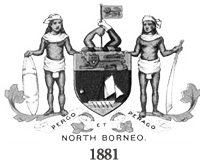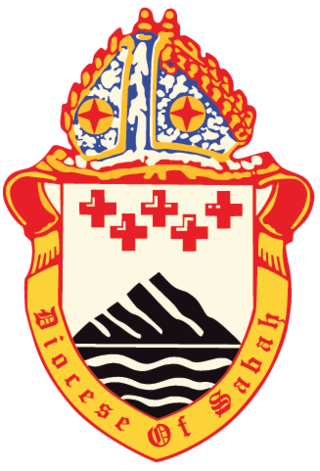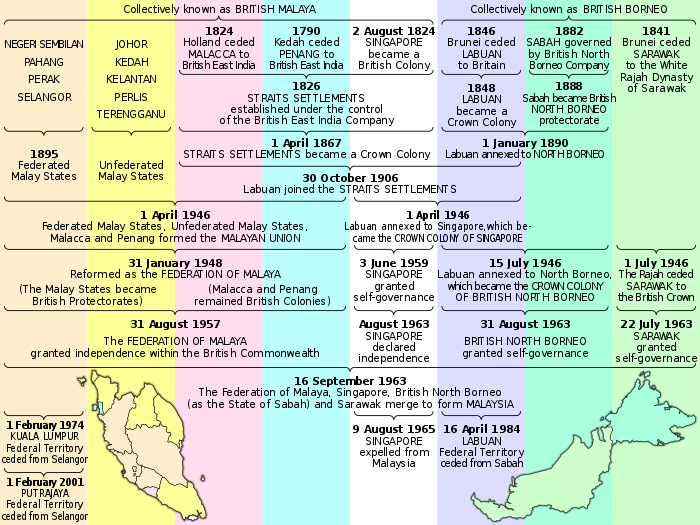
Borneo is the third-largest island in the world, with an area of 748,168 km2 (288,869 sq mi). Situated at the geographic centre of Maritime Southeast Asia, it is one of the Greater Sunda Islands, located north of Java, west of Sulawesi, and east of Sumatra.

East Malaysia, or the Borneo States, also known as Malaysian Borneo, is the part of Malaysia on and near the island of Borneo, the world's third-largest island. East Malaysia comprises the states of Sabah, Sarawak, and the Federal Territory of Labuan. The small independent nation of Brunei comprises two enclaves in Sarawak. To the south and southeast is the Indonesian portion of Borneo, Kalimantan. East Malaysia lies to the east of Peninsular Malaysia, the part of the country on the Malay Peninsula. The two are separated by the South China Sea.

Labuan, officially the Federal Territory of Labuan, is an island federal territory of Malaysia. Its territory includes Labuan Island and six smaller islands, off the coast of the state of Sabah in East Malaysia. Labuan's capital is Victoria and is best known as an offshore financial centre offering international financial and business services via Labuan IBFC since 1990 as well as being an offshore support hub for deepwater oil and gas activities in the region. It is also a tourist destination for people travelling through Sabah, nearby Bruneians and scuba divers. The name Labuan derives from the Malay word labuhan which means harbour.

North Borneo was a British protectorate in the northern part of the island of Borneo,. The territory of North Borneo was originally established by concessions of the Sultanates of Brunei and Sulu in 1877 and 1878 to a German-born representative of Austria-Hungary, businessman and diplomat, Gustav Overbeck.
North Borneo, located in the northern part of the island of Borneo, was a British protectorate from 1888 and a British Crown colony after 1946.
An apostolic prefect or prefect apostolic is a priest who heads what is known as an apostolic prefecture, a 'pre-diocesan' missionary jurisdiction where the Catholic Church is not yet sufficiently developed to have it made a diocese. Although it usually has an (embryonal) see, it is often not called after such city but rather after a natural feature, or administrative geographical area, which may be a name in use by the local inhabitants, or one assigned by a colonial authority, depending on the circumstances under which the prefecture was established.

The North Borneo Chartered Company (NBCC), also known as the British North Borneo Company (BNBC) was a British chartered company formed on 1 November 1881 to administer and exploit the resources of North Borneo. The territory became a protectorate of the British Empire in 1888 but the company remained involved with the territory until 1946, when administration was fully assumed by the Crown colony government.

Victoria, sometimes known as Bandar Labuan or simply Labuan, is the capital of the Federal Territory of Labuan in Malaysia, an island group off the north coast of Borneo. It is in the southeast corner of Labuan and its Malay name, Bandar Victoria, is commonly used to honour the reign of Queen Victoria. The town is an urban district within the wider city limits of Victoria which includes Labuan Port, a sheltered deep-water harbour which is an important trans-shipment point for Brunei Darussalam, northern Sarawak and western Sabah.

The Church of the Province of South East Asia is an autonomous member of the Anglican Communion, created in 1996 with the four dioceses of Kuching, Sabah, Singapore and West Malaysia.

The Battle of Borneo was a successful campaign by Japanese Imperial forces for control of Borneo island and concentrated mainly on the subjugation of the Raj of Sarawak, Brunei, North Borneo, and the western part of Kalimantan that was part of the Dutch East Indies. The Japanese main unit for this mission was the 35th Infantry Brigade led by Major General Kiyotake Kawaguchi.
The Diocese of Kuching is a diocese of the Anglican Church of the Province of South East Asia that covers Sarawak and Brunei. Founded in 1962, the see was originally established as the Bishopric of Sarawak linked to the Diocese of Labuan in 1855. The current bishop is the Most Rev'd Danald Jute, 14th Lord Bishop of the Diocese of Kuching and Brunei, who was consecrated on 13 August 2017. His seat is at St. Thomas' Cathedral, Kuching.

The Diocese of Sabah is an Anglican diocese which covers Sabah and Labuan in Malaysia. Founded in 1962, the see was originally part of the much larger Diocese of Labuan and its Dependencies which was established in 1855. Following the carving out of the Diocese of Singapore in 1909 from this last ecclesiastical territory, the area of the present-day Diocese fell under the jurisdiction of the Diocese of Labuan & Sarawak, which was reorganised as the Diocese of Borneo in 1949. In 1962, the latter diocese was divided into two, forming the Diocese of Kuching and the Diocese of Jesselton, which was renamed the Diocese of Sabah when the capital city was given the new name of Kota Kinabalu in 1967.

The History of Sarawak can be traced as far as 40,000 years ago to the paleolithic period where the earliest evidence of human settlement is found in the Niah caves. A series of Chinese ceramics dated from the 8th to 13th century AD was uncovered at the archeological site of Santubong. The coastal regions of Sarawak came under the influence of the Bruneian Empire in the 16th century. In 1839, James Brooke, a British explorer, first arrived in Sarawak. Sarawak was later governed by the Brooke family between 1841 and 1946. During World War II, it was occupied by the Japanese for three years. After the war, the last White Rajah, Charles Vyner Brooke, ceded Sarawak to Britain, and in 1946 it became a British Crown Colony. On 22 July 1963, Sarawak was granted self-government by the British. Following this, it became one of the founding members of the Federation of Malaysia, established on 16 September 1963. However, the federation was opposed by Indonesia, and this led to the three-year Indonesia–Malaysia confrontation. From 1960 to 1990, Sarawak experienced a communist insurgency.

The history of Sabah can be traced back to about 23–30,000 years ago when evidence suggests the earliest human settlement in the region existed. The history is interwoven with the history of Brunei and the history of Malaysia, which Sabah was previously part of and is currently part of respectively. The earliest recorded history of Sabah being part of any organised civilisation began in the early 15th century during the thriving era of the Sultanate of Brunei. Prior to this, early inhabitants of the land lived in predominantly tribal societies, although such tribal societies had continued to exist until the 1900s. The eastern part of Sabah was ceded to the Sultan of Sulu by the Sultan of Brunei in 1658 for the former helping a victory over Brunei enemies, but many sources stated it had not been ceded at all. By the late 19th century, both territories previously owned by Sultan of Brunei and Sultan of Sulu was granted to British syndicate and later emerged as British North Borneo under the management of the North Borneo Chartered Company. Sabah became a protectorate of the United Kingdom in 1888 and subsequently became a Crown colony from 1946 until 1963, during which time it was known as Crown Colony of North Borneo. On 16 September 1963, Sabah merged with Malaya, Sarawak and Singapore to form Malaysia.

The Crown Colony of Labuan was a Crown colony off the northwestern shore of the island of Borneo established in 1848 after the acquisition of the island of Labuan from the Sultanate of Brunei in 1846. Apart from the main island, Labuan consists of six smaller islands; Burung, Daat, Kuraman, Papan, Rusukan Kecil, and Rusukan Besar.

Before the outbreak of World War II in the Pacific, the island of Borneo was divided into five territories. Four of the territories were in the north and under British control – Sarawak, Brunei, Labuan, an island, and British North Borneo; while the remainder, and bulk, of the island, was under the jurisdiction of the Dutch East Indies.

Borneo Cup is a football tournament held in East Malaysia and Brunei. The tournament was played in Borneo since the 1950s, perhaps earlier. Before the establishment of Malaysia on 16 September 1963, the tournament was contested by three national teams, North Borneo, Sarawak and Brunei. After North Borneo and Sarawak formed Malaysia together with Malaya and Singapore, it competed as states of Malaysia.

The Crown Colony of North Borneo was a Crown colony on the island of Borneo established in 1946 shortly after the dissolution of the British Military Administration. The Crown Colony of Labuan joined the new Crown colony during its formation. It was succeeded as the state of Sabah through the formation of the Federation of Malaysia on 16 September 1963.

The British Military Administration (BMA) was the interim administrator of British Borneo between the end of the Second World War and the establishment of the Crown Colonies of Sarawak and North Borneo in 1946. Specifically, the entity lasted from 12 September 1945 to 1 July 1946. Labuan became the headquarters of BMA. The headquarters was mostly managed by the Australian Imperial Force (AIF). The area under this administration today comprises Labuan, Sabah, Sarawak, and Brunei. Sarawak was administered by Australians under British Borneo Civil Affairs Unit (BBCAU).

Sarawak Independence Day is a holiday celebrated on 22 July annually by Sarawak, celebrating the establishment of de facto self-government on 22 July 1963.



















